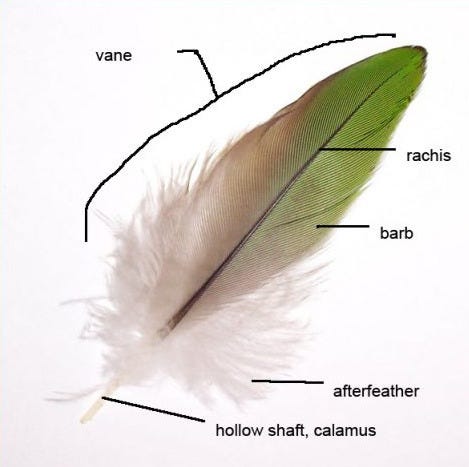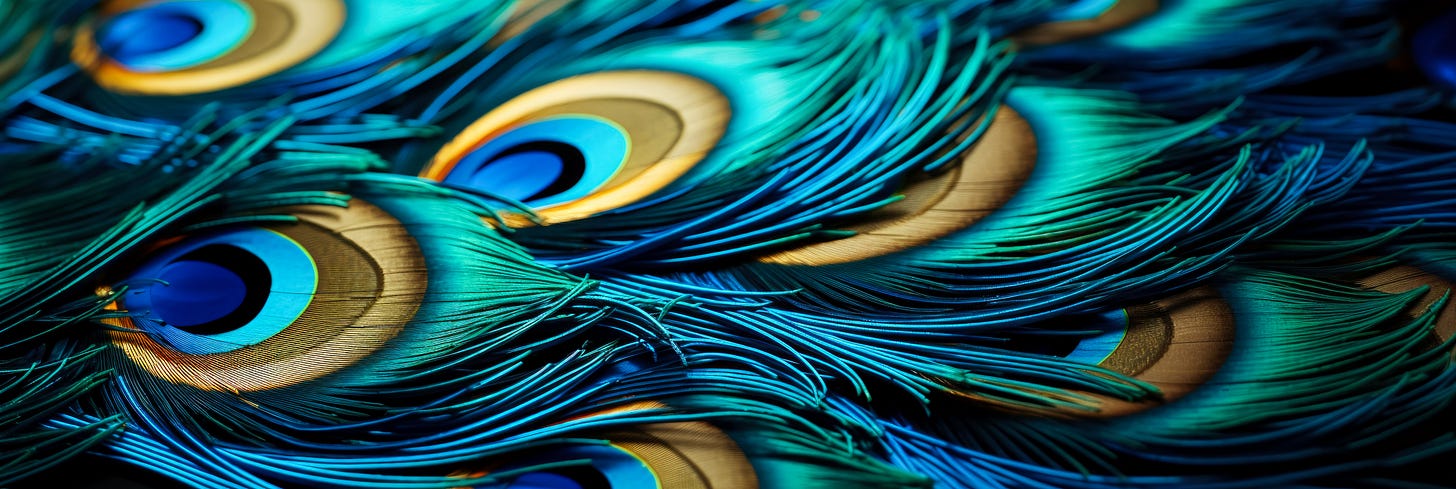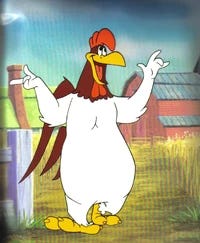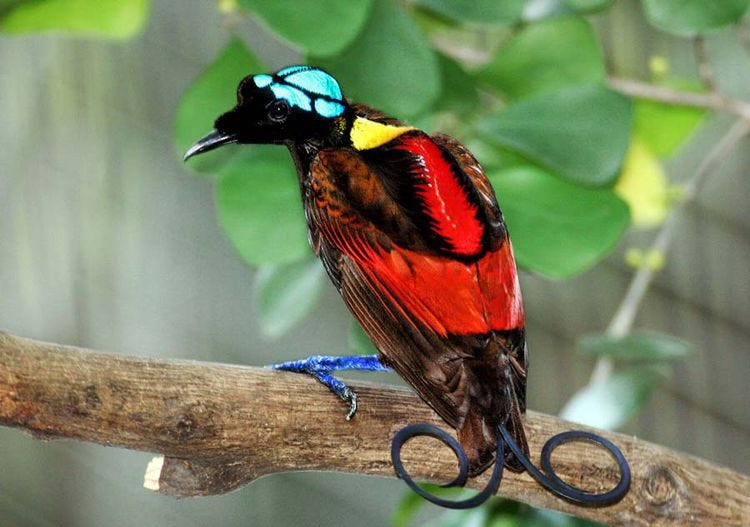Feathers--Wonders within Wonders
Flight Design, Color, Symmetry, and Stunning Beauty Hiding in Plain Sight
Note to My Readers
I’ll admit—I fell down a rabbit hole with this one. Feathers seemed like a simple topic— at first, but, the deeper I looked, the more gob-smacking wonder I found. Turns out, it’s a bottomless subject—layer after layer of beauty, design, and purpose. Just Google “Long tail-feathers of birds,” and you’ll see what I mean. I hope you enjoy exploring feathers as much as I did.
___
Children are naturally drawn to feathers. Do you remember finding them at the high water line of a lake or on a woodsy path?
There’s something about their lightness, their gentle curve, their silken texture that invites touch—makes you want to trace a finger along the vane and watch it respond, supple and alive.
There were always feathers on our wonder table along with shiny rocks, pine cones, bug shells, and droopy flowers. The found feathers seemed to prompt curiosity: What kind of bird did this come from? What adventure had its owner been on?
The Fingerprint of God
When I find a feather it feels like a gift. Why? Perhaps because of their symmetry.
Feathers are built on symmetry—Each feather begins with a central shaft (rachis), flanked by rows of barbs that hook together with microscopic barbules. If you’ve ever seen a feather come apart, you know you can gently run your fingers along it—and it re-zips like magic. That “magic” is intricate design, down to the smallest detail.
Engineers study the symmetry of feathers to design better aircraft and materials. They look for what works. In something so small as a feather, we see the fingerprint of God.
Different feathers serve different purposes:
Down feathers keep birds warm
Contour feathers give shape and smoothness
Flight feathers provide lift and control
Tail feathers help steer and balance
Every bird is dressed precisely for its way of life. The robin, the hawk, the hummingbird—all clothed in wisdom not their own.
“Consider the birds of the air…”—Matthew 6:26
A Feather Atlas—Who Knew?
Take a close look at the feather above. Notice how each barb shimmers with delicate light, revealing an intricate pattern and symmetry. Even the simplest feather can astonish us with its beauty and brilliant design.
Imagine an entire atlas of feathers—hundreds of them.
The U.S. Fish & Wildlife Service hosts an incredible visual database of flight feathers from over 400 North American bird species. You’ll find crisp, detailed images of both primary and secondary feathers—the ones specially built for flight. Long, tapered, and strong, these feathers are engineered to lift, steer, and stabilize birds in the air.
It’s a marvelous resource for nature journaling, bird identification, or simply pausing to wonder at the design woven into the wing of every sparrow, hawk, and wren.
🖱️ Explore here: https://www.fws.gov/lab/featheratlas
Beauty by Design
Feathers don’t just serve a function—they shimmer and shine with beauty.
Some get their color from pigments. Others—like peacocks and hummingbirds—gleam with structural color, created not by dye but by the feather’s microscopic design. These feathers bend and reflect light like prisms, dazzling the eye in sunlight.
Not all feathers call attention to themselves. Sparrows, owls, wrens—these birds wear earth-toned feathers that blend into bark, leaf, and shadow. Camouflage is not the absence of beauty—it is their beauty.
And, feathers change. Birds molt. Colors fade, then return with the seasons. Some grow brilliant tails for courtship. Others turn pure white for winter. Each stage, each shift, is part of the design. The feather is constructed of keratin—the same tough, flexible protein that makes up our hair and fingernails..
Wait—Do Penguins Really Have Feathers?
Not all feathers are made for flying.
Penguins have feathers, too—thousands of them.
Tiny, stiff, tightly packed, their feathers aren’t for lift, but for warmth and waterproofing. A penguin’s outer feathers overlap like shingles, keeping icy water out. Beneath these feathers, a layer of fluffy down traps heat close to the body. This specialized feather system allows penguins to dive deep into frigid seas and waddle across Antarctic winds without freezing.
It's a beautiful reminder: not all gifts look the same. Some are seen in flight. Others are hidden, quiet, yet just as necessary. Even in the coldest places, God provides covering.
Sayings to Ruffle Your Feathers
Feathers and birds have given us some of the most memorable idioms—those colorful figures of speech that still flutter through everyday conversation. Teaching children to understand and use them not only puts a feather in their cap—it also helps feather their nest for the future.
Here are a few feathered expressions worth sharing, remembering, and maybe even slipping into your next story or nature journal.
Like water off a duck’s back
Used when trouble or criticism doesn’t affect someone at all.Ruffle someone’s feathers
To upset, annoy, or agitate someone.A feather in your cap
A proud achievement or honor.Birds of a feather flock together
People with similar interests or character tend to stick together.Light as a feather
Extremely lightweight or delicate.Feather one’s nest
To enrich oneself, often selfishly or dishonestly.You could have knocked me over with a feather
An expression of extreme surprise or shock.Fine feathers make fine birds
Good clothing or appearance makes a person look impressive (sometimes used ironically).Fly the coop
To escape or leave suddenly.
Humorous Side-note—Below is Foghorn Leghorn from the Warner Brothers Looney Tunes Cartoons of my youth. Foghorn would often quip: “I say, I say now—listen here, my fine feathered friends—this here barnyard don’t run itself!”
Feathers and the Birth of the Audobon Society
During the Gilded Age (1870 to 1900), it was fashionable for women to wear plumes of feathers in their hats. Those plumes came from herons, woodpeckers, bluebirds, owls, warblers, and even humminbords.. Thousands were killed each year.In the nineteenth century—especially from exotic birds. Entire birds or elaborate plumes were often used to decorate bonnets and headpieces, leading to the widespread hunting of species like egrets, herons, and birds of paradise.
This craze, known as the “plume trade,” devastated bird populations worldwide. The public outcry, led by women and early conservationists, sparked the formation of the Audubon Society. By the early 1900s, laws like the Migratory Bird Treaty Act of 1918 were enacted in the U.S. to ban the hunting and trade of many native birds for their feathers, marking one of the first major victories for wildlife protection.
An Invitation to Wonder
This week, look for feathers. They may be tucked in the grass, caught in a bush, or, floating down from above.
Start a feather journal. Add one to your nature shelf. Ask your children:
What kind of feather is this?
What bird might it have come from?
What is it made to do?
Because sometimes, the best way to teach a child about flight… is to show them the feather.
Here is a Learning About Feathers lesson in printable form. Please enjoy it with your children and let me know how it goes. In the lesson, there is an checklist to determine which kind of feather it is. Your children will delight in this easy rubric to learn more about feathers.
🕊️ A Free, Live Webinar
If you enjoyed this post, consider sharing it with a friend or fellow homeschooler.
And, if you’re preparing for the year ahead, I invite you to join me for something special:
Planning Your Homeschool Year—with Grace
A free live webinar with Sheila Carroll
📅 Tuesday, July 15 at 2:00 PM ET
🔗 [Register Here]
Whether you're just beginning or have been homeschooling for years, this is your invitation to pause, breathe, and begin again—from a place of hope, not hurry.
A circle is already forming. Come join us.
Grateful for your support,
Sheila Carroll
Living Books Press








Also psalm 91,4❤️
Thank you! So much to ponder!🤗